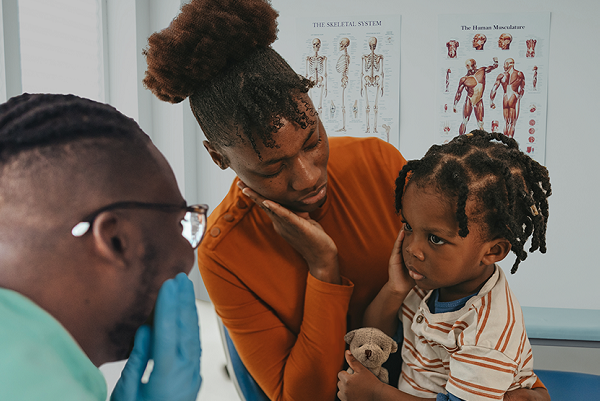 This resource includes tips and information for Head Start staff and other early childhood program staff to care for a child with sickle cell disease.
This resource includes tips and information for Head Start staff and other early childhood program staff to care for a child with sickle cell disease.
What is sickle cell disease?
Sickle cell disease (SCD) is a health condition that some children may have when they are born. Healthy red blood cells are round and easily move through blood vessels to carry oxygen to all parts of the body. In someone who has SCD, the red blood cells are not round, but shaped like a letter “C.” These cells can get stuck and block blood flow to some parts of the body. This can cause pain, infection, and other serious problems, such as having difficulty breathing or having trouble moving or seeing. These sickle cells don’t live as long as round blood cells, and they cause anemia. As a result, children with SCD may often have low energy or get tired more easily.
Sickle cell disease is diagnosed with a blood test. In the United States, SCD is most often found at birth during routine newborn screening tests. Because children with SCD are at an increased risk of infection and other health problems, early diagnosis and treatment are critical. Some people are born with sickle cell trait and not the disease. They do not usually have any symptoms.
It is important for families with a child who has been diagnosed with the disease or has the sickle cell trait to discuss what this means for their child and their entire family with their health care provider. They may also benefit from referrals to medical specialists, mental health professionals, and peer support groups.
Sickle cell disease and sickle cell trait are most common among people of African descent. In the U.S., SCD is seen in 1 out of every 365 Black or African American babies. SCD and sickle cell trait are also more common in people with Latin American, South Asian, Southern European, and Middle Eastern ancestry.
Partnering with Families
Keep the following considerations in mind when partnering with families:
- Families are the first source of information on how they understand and manage their child’s health condition and medications, including schedules and routines. They know what works and doesn’t work when caring for their child.
- You usually cannot see what is making a child with SCD hurt. It is very important for adults to know how each child with SCD communicates when they are in pain and what usually helps them.
- Supporting a child with SCD requires a team. Every child with SCD deserves access to appropriate care and treatment to help them live, learn, and play.
- Develop an Individual Health Care Plan (IHP) with the child’s family and health care provider. Review the plan with the family and consider the implications for the program. The IHP should include:
- Emergency contact information.
- Signs and symptoms of an emergency and what action to take.
- When to contact the child’s family and when to seek urgent medical care.
- Special instructions for caring for the child, such as when they are in pain, have a fever, or are dehydrated.
- Medications the child may need while in the program for maintenance or emergencies.
Caring for Children with Sickle Cell Disease
Everyone involved in the care of a child needs to be trained and supported so that they understand and can implement the IHP.
Be sure all staff who care for a child with SCD follow these strategies:
- Make sure the child drinks plenty of water. Provide small amounts of water frequently throughout the day to prevent dehydration.
- Do not let the child get too hot or too cold. This may mean taking breaks to cool down during or after physical activity, making sure the child has appropriate clothing for outdoor activities, and limiting activity during very hot or cold weather.
- Avoid the use of ice packs for an injury.
- Provide rest breaks if the child is getting tired.
- Common illnesses can be dangerous for children with SCD. Prevent infections by:
- Washing hands frequently.
- Following food safety practices.
- Keeping children with SCD from touching reptiles such as turtles, snakes, and lizards.
- Encouraging children and staff in the program to receive recommended vaccinations. Children with SCD are considered “high risk” for certain infections and may follow a special vaccination schedule.
When to Seek Medical Care
Take action immediately if the child is experiencing:
- Fever above 101
- Pain anywhere in the body that will not go away
- Swelling of hands or feet
- Difficulty breathing
- Chest pain
- Belly pain or swelling
- Extreme tiredness
- Whites of the eyes look yellow
- Lips or skin are more pale
- Severe headache
- Sudden loss of feeling or trouble moving the body
- Droopy face or an eye that doesn’t close
- Any sudden problem with vision or difficulty speaking
- Seizure
Each family with a child with special health care needs presents unique strengths and challenges. Caring relationships with program staff support the well-being of all family members.
Ongoing Communication with Families
Check in frequently with the child’s family to find out if they need help finding medical providers who are familiar with SCD, getting medicines, or making appointments.
Share these additional resources with families:
- Communication Resources on Sickle Cell Disease
- Sickle Cell Disease: Information for Parents
- Sickle Cell Disease
- Sickle Cell Disease Association of America
Last Updated: May 24, 2024
